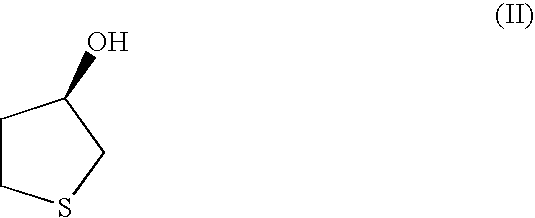Method for Manufacturing Optically Active Tetrahydrothiophene Derivative and Method for Crystallization of Optically Active Tetrahydrothiophene-3-Ol
a technology of which is applied in the field of manufacturing optically active tetrahydrothiophene derivative and crystallization method of optically active tetrahydrothiophene3ol, can solve the problems of high cost of reagents, low yield, and unsatisfactory industrial production methods, and achieve high selectivity
- Summary
- Abstract
- Description
- Claims
- Application Information
AI Technical Summary
Problems solved by technology
Method used
Image
Examples
example 1
[0043]A 25 mL quantity of F1 medium (potato starch 20 g / L, glucose 10 g / L, soy flour 20 g / L, potassium dihydrogenphosphate 1 g / L, magnesium sulfate heptahydrate 0.5 g / L) was poured into a 250 mL conical flask and sterilized with high-pressure steam for 20 minutes at 121° C. This mixture was inoculated with Aspergillus ochraceus ATCC18500, and shaking culturing was conducted for 72 hours at 25° C. A 30 mg quantity of tetrahydrothiophene-3-one was added to the culture solution obtained, and the mixture was shaken for 24 hours at 25° C.
[0044]The reaction solution obtained was extracted with ethyl acetate (15 mL×3). The organic layers were combined and dried over sodium sulfate and then concentrated after filtration. The residue was separated and purified by preparative TLC (hexane / ethyl acetate=1 / 1) to give 12 mg of the target product (a yield of 39 percent) with an optical purity of 81 percent e.e. (R).; [α]D=+8.8(c=0.5, CHCl3); 1H—NMR(CDCl3) δ(ppm): 1.75(m, 2H), 2.15(m, 1H), 2.82-3.1...
example 2
[0046]With the exceptions that Penicillium vinaceum IAM7143 was employed and a 50 mg quantity of substrate was added, the conversion reaction was conducted in the same manner as in Example 1. This yielded 11 mg of target product (a yield of 22 percent) with an optical purity of 91 percent e.e. (R).
example 3
[0047]With the exception that Streptomyces michiganensis NBRC12797 was employed, the conversion reaction was conducted in the same manner as in Example 2. This yielded 32 mg of target product (a yield of 79 percent) with an optical purity of 88 percent e.e. (R).
PUM
| Property | Measurement | Unit |
|---|---|---|
| temperature | aaaaa | aaaaa |
| crystallization temperature | aaaaa | aaaaa |
| pH | aaaaa | aaaaa |
Abstract
Description
Claims
Application Information
 Login to View More
Login to View More - R&D
- Intellectual Property
- Life Sciences
- Materials
- Tech Scout
- Unparalleled Data Quality
- Higher Quality Content
- 60% Fewer Hallucinations
Browse by: Latest US Patents, China's latest patents, Technical Efficacy Thesaurus, Application Domain, Technology Topic, Popular Technical Reports.
© 2025 PatSnap. All rights reserved.Legal|Privacy policy|Modern Slavery Act Transparency Statement|Sitemap|About US| Contact US: help@patsnap.com



